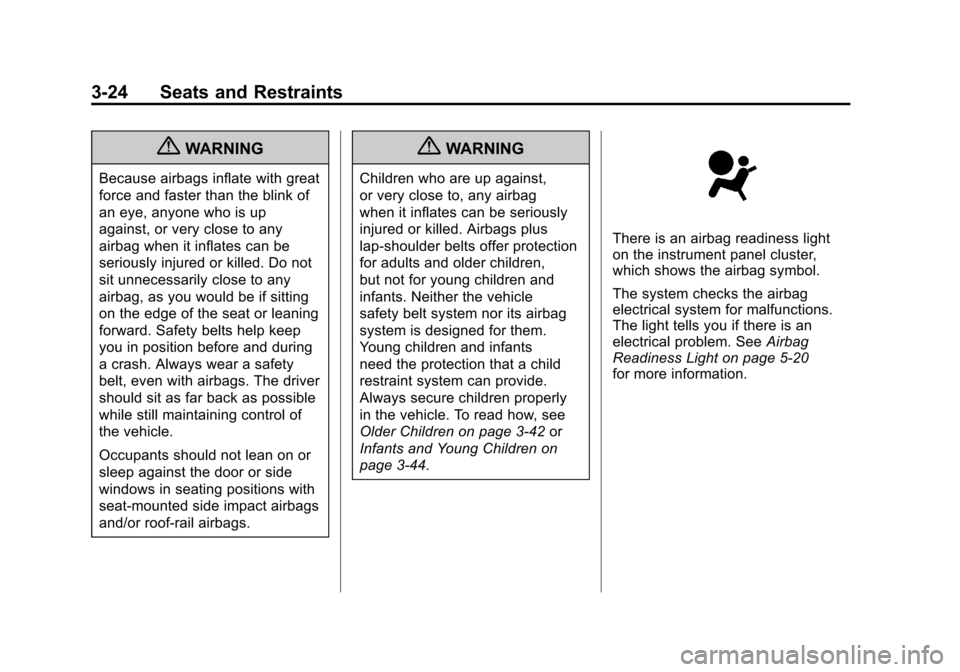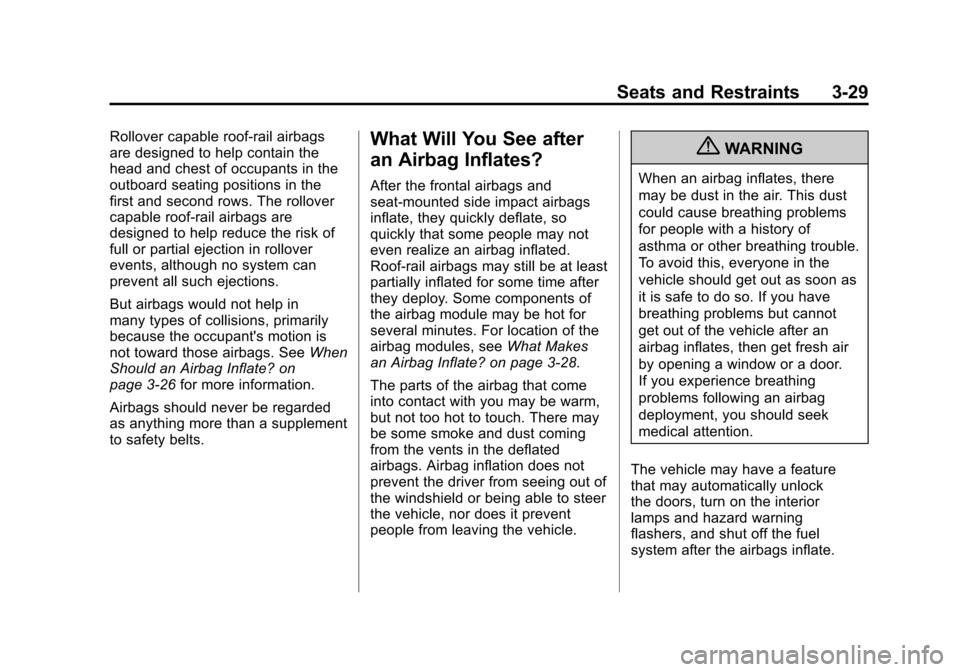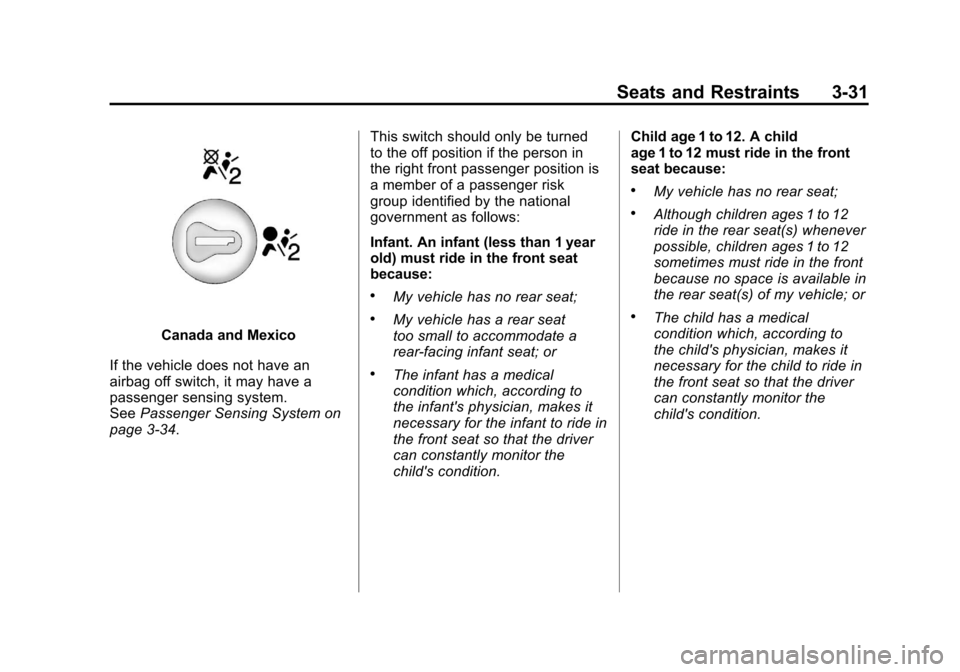2012 CHEVROLET SILVERADO airbag off
[x] Cancel search: airbag offPage 10 of 584

Black plate (4,1)Chevrolet Silverado Owner Manual - 2012
1-4 In Brief
V.Power Outlets on page 5‑10.
W. Climate Control Systems
(with Air Conditioning) on
page 8‑1 orClimate Control
Systems (with Heater Only) on
page 8‑4 (If Equipped).
Dual Automatic Climate
Control System on page 8‑5
(If Equipped).
X. Power Take Off (PTO) Control (If Equipped). See Power
Take Off (PTO) in the Duramax
diesel supplement.
Y. Passenger Airbag Off Control (If Equipped). See Airbag
On-Off Switch on page 3‑30.
Page 13 of 584

Black plate (7,1)Chevrolet Silverado Owner Manual - 2012
In Brief 1-7
A.Air Vents on page 8‑11.
B. Turn and Lane‐Change Lever. See Turn and Lane-Change
Signals on page 6‑6.
Windshield Wiper/Washer on
page 5‑5.
C. Instrument Cluster on
page 5‑13.
D. Hazard Warning Flashers on
page 6‑5 (Out of View).
E. Shift Lever. See Automatic
Transmission on page 9‑38.
Range Selection Mode
(If Equipped). See Manual
Mode on page 9‑42.
F. Tow/Haul Mode on page 9‑43
(If Equipped).
G. Driver Information Center (DIC) Buttons. See Driver Information
Center (DIC) on page 5‑32.
H. Infotainment on page 7‑1.
I. Exterior Lamp Controls on
page 6‑1. J. Integrated Trailer Brake
Controller (If Equipped).
See Trailer Towing on
page 9‑86.
K. Dome Lamps on page 6‑8.
L. Automatic Transfer Case Control (If Equipped).
See Four-Wheel Drive on
page 10‑32.
M. Data Link Connector (DLC) (Out of View). See Malfunction
Indicator Lamp on page 5‑24.
N. Hood Release. See Hood on
page 10‑5.
O. Parking Brake on page 9‑60.
P. Cruise Control on page 9‑66.
Q. Steering Wheel Adjustment on
page 5‑2.
R. Horn on page 5‑5.
S. Steering Wheel Controls on
page 5‑3. T.
Climate Control Systems
(with Air Conditioning) on
page 8‑1 orClimate Control
Systems (with Heater Only) on
page 8‑4 (If Equipped).
Dual Automatic Climate
Control System on page 8‑5
(If Equipped).
U. Power Outlets on page 5‑10.
Cigarette Lighter (If Equipped).
See Ashtrays on page 5‑12 and
Cigarette Lighter on page 5‑11.
V. StabiliTrak
®System on
page 9‑62 (If Equipped).
Pedal Adjust Button
(If Equipped). See Adjustable
Throttle and Brake Pedal on
page 9‑26.
Ultrasonic Parking Assist on
page 9‑68 (If Equipped).
Exhaust Brake (If Equipped).
See “Brakes” in the Duramax
diesel supplement.
W. Passenger Airbag Off Control (If Equipped). See Airbag
On-Off Switch on page 3‑30.
Page 21 of 584

Black plate (15,1)Chevrolet Silverado Owner Manual - 2012
In Brief 1-15
Safety Belts
Refer to the following sections for
important information on how to use
safety belts properly.
.Safety Belts on page 3‑13.
.How to Wear Safety Belts
Properly on page 3‑14.
.Lap-Shoulder Belt on page 3‑15.
.Lower Anchors and Tethers for
Children (LATCH System) on
page 3‑51.
Passenger Sensing
System
The passenger sensing system,
if equipped, turns off the front
outboard passenger frontal airbag
under certain conditions. No other
airbag is affected by the passenger
sensing system.
If the vehicle has one of the
indicators pictured in the following
illustrations, then the vehicle has a
passenger sensing system for the
right front passenger position unless
there is an airbag off switch located
in the glove box.
If there is an airbag off switch, the
vehicle does not have a passenger
sensing system. SeeAirbag On-Off
Switch on page 3‑30 for more
information. The passenger airbag status
indicator will be visible on the
overhead console when the vehicle
is started.
United States
Canada and Mexico
See Passenger Sensing System on
page 3‑34 for important information.
Page 65 of 584

Black plate (1,1)Chevrolet Silverado Owner Manual - 2012
Seats and Restraints 3-1
Seats and
Restraints
Head Restraints
Head Restraints . . . . . . . . . . . . . . . 3-2
Front Seats
Seat Adjustment . . . . . . . . . . . . . . 3-3
Center Seat . . . . . . . . . . . . . . . . . . . 3-5
Power Seat Adjustment . . . . . . . 3-5
Lumbar Adjustment . . . . . . . . . . . 3-6
Reclining Seatbacks . . . . . . . . . . 3-6
Memory Seats . . . . . . . . . . . . . . . . 3-8
Heated and Ventilated FrontSeats . . . . . . . . . . . . . . . . . . . . . . . 3-10
Rear Seats
Rear Seats (Extended CabFull Bench) . . . . . . . . . . . . . . . . . 3-11
Rear Seats (All Split Bench and Hybrid Full Bench) . . . . . 3-12
Safety Belts
Safety Belts . . . . . . . . . . . . . . . . . . 3-13
How to Wear Safety BeltsProperly . . . . . . . . . . . . . . . . . . . . 3-14
Lap-Shoulder Belt . . . . . . . . . . . 3-15 Safety Belt Use During
Pregnancy . . . . . . . . . . . . . . . . . . 3-20
Lap Belt . . . . . . . . . . . . . . . . . . . . . 3-20
Safety Belt Extender . . . . . . . . . 3-21
Safety System Check . . . . . . . . 3-21
Safety Belt Care . . . . . . . . . . . . . 3-22
Replacing Safety Belt System Parts after a Crash . . . . . . . . . 3-22
Airbag System
Airbag System . . . . . . . . . . . . . . . 3-23
Where Are the Airbags? . . . . . 3-25
When Should an AirbagInflate? . . . . . . . . . . . . . . . . . . . . . 3-26
What Makes an Airbag Inflate? . . . . . . . . . . . . . . . . . . . . . 3-28
How Does an Airbag
Restrain? . . . . . . . . . . . . . . . . . . . 3-28
What Will You See after an Airbag Inflates? . . . . . . . . . . . . 3-29
Airbag On-Off Switch . . . . . . . . 3-30
Passenger Sensing System . . . . . . . . . . . . . . . . . . . . . 3-34
Servicing the Airbag-Equipped Vehicle . . . . . . . . . . . . . . . . . . . . . 3-38 Adding Equipment to the
Airbag-Equipped Vehicle . . . 3-39
Airbag System Check . . . . . . . . 3-41
Replacing Airbag System Parts after a Crash . . . . . . . . . 3-41
Child Restraints
Older Children . . . . . . . . . . . . . . . 3-42
Infants and Young
Children . . . . . . . . . . . . . . . . . . . . 3-44
Child Restraint Systems . . . . . 3-47
Where to Put the Restraint . . . 3-49
Lower Anchors and Tethers for Children (LATCH
System) . . . . . . . . . . . . . . . . . . . . 3-51
Replacing LATCH System Parts After a Crash . . . . . . . . . 3-60
Securing Child Restraints (Rear Seat Position) . . . . . . . . 3-60
Securing Child Restraints (Center Front Seat
Position) . . . . . . . . . . . . . . . . . . . 3-62
Securing Child Restraints (Right Front Seat
Position) . . . . . . . . . . . . . . . . . . . 3-63
Page 88 of 584

Black plate (24,1)Chevrolet Silverado Owner Manual - 2012
3-24 Seats and Restraints
{WARNING
Because airbags inflate with great
force and faster than the blink of
an eye, anyone who is up
against, or very close to any
airbag when it inflates can be
seriously injured or killed. Do not
sit unnecessarily close to any
airbag, as you would be if sitting
on the edge of the seat or leaning
forward. Safety belts help keep
you in position before and during
a crash. Always wear a safety
belt, even with airbags. The driver
should sit as far back as possible
while still maintaining control of
the vehicle.
Occupants should not lean on or
sleep against the door or side
windows in seating positions with
seat-mounted side impact airbags
and/or roof-rail airbags.
{WARNING
Children who are up against,
or very close to, any airbag
when it inflates can be seriously
injured or killed. Airbags plus
lap-shoulder belts offer protection
for adults and older children,
but not for young children and
infants. Neither the vehicle
safety belt system nor its airbag
system is designed for them.
Young children and infants
need the protection that a child
restraint system can provide.
Always secure children properly
in the vehicle. To read how, see
Older Children on page 3‑42or
Infants and Young Children on
page 3‑44.
There is an airbag readiness light
on the instrument panel cluster,
which shows the airbag symbol.
The system checks the airbag
electrical system for malfunctions.
The light tells you if there is an
electrical problem. See Airbag
Readiness Light on page 5‑20
for more information.
Page 93 of 584

Black plate (29,1)Chevrolet Silverado Owner Manual - 2012
Seats and Restraints 3-29
Rollover capable roof-rail airbags
are designed to help contain the
head and chest of occupants in the
outboard seating positions in the
first and second rows. The rollover
capable roof-rail airbags are
designed to help reduce the risk of
full or partial ejection in rollover
events, although no system can
prevent all such ejections.
But airbags would not help in
many types of collisions, primarily
because the occupant's motion is
not toward those airbags. SeeWhen
Should an Airbag Inflate? on
page 3‑26 for more information.
Airbags should never be regarded
as anything more than a supplement
to safety belts.What Will You See after
an Airbag Inflates?
After the frontal airbags and
seat-mounted side impact airbags
inflate, they quickly deflate, so
quickly that some people may not
even realize an airbag inflated.
Roof-rail airbags may still be at least
partially inflated for some time after
they deploy. Some components of
the airbag module may be hot for
several minutes. For location of the
airbag modules, see What Makes
an Airbag Inflate? on page 3‑28.
The parts of the airbag that come
into contact with you may be warm,
but not too hot to touch. There may
be some smoke and dust coming
from the vents in the deflated
airbags. Airbag inflation does not
prevent the driver from seeing out of
the windshield or being able to steer
the vehicle, nor does it prevent
people from leaving the vehicle.
{WARNING
When an airbag inflates, there
may be dust in the air. This dust
could cause breathing problems
for people with a history of
asthma or other breathing trouble.
To avoid this, everyone in the
vehicle should get out as soon as
it is safe to do so. If you have
breathing problems but cannot
get out of the vehicle after an
airbag inflates, then get fresh air
by opening a window or a door.
If you experience breathing
problems following an airbag
deployment, you should seek
medical attention.
The vehicle may have a feature
that may automatically unlock
the doors, turn on the interior
lamps and hazard warning
flashers, and shut off the fuel
system after the airbags inflate.
Page 94 of 584

Black plate (30,1)Chevrolet Silverado Owner Manual - 2012
3-30 Seats and Restraints
You can lock the doors, turn off the
interior lamps and hazard warning
flashers by using the controls for
those features.
{WARNING
A crash severe enough to inflate
the airbags may have also
damaged important functions in
the vehicle, such as the fuel
system, brake and steering
systems, etc. Even if the vehicle
appears to be drivable after a
moderate crash, there may be
concealed damage that could
make it difficult to safely operate
the vehicle.
Use caution if you should attempt
to restart the engine after a crash
has occurred.
In many crashes severe enough to
inflate the airbag, windshields are
broken by vehicle deformation. Additional windshield breakage may
also occur from the right front
passenger airbag.
.Airbags are designed to inflate
only once. After an airbag
inflates, you will need some new
parts for the airbag system.
If you do not get them, the
airbag system will not be there
to help protect you in another
crash. A new system will include
airbag modules and possibly
other parts. The service manual
for your vehicle covers the need
to replace other parts.
.The vehicle has a crash sensing
and diagnostic module which
records information after a
crash. See
Vehicle Data
Recording and Privacy on
page 13‑19 andEvent Data
Recorders on page 13‑20.
.Let only qualified technicians
work on the airbag systems.
Improper service can mean that
an airbag system will not work
properly. See your dealer for
service.
Airbag On-Off Switch
If one of the switches pictured in the
following illustrations is located in
the glove box, the vehicle has an
airbag on-off switch that you can
use to manually turn on or off the
right front passenger airbag.
United States
Page 95 of 584

Black plate (31,1)Chevrolet Silverado Owner Manual - 2012
Seats and Restraints 3-31
Canada and Mexico
If the vehicle does not have an
airbag off switch, it may have a
passenger sensing system.
See Passenger Sensing System on
page 3‑34. This switch should only be turned
to the off position if the person in
the right front passenger position is
a member of a passenger risk
group identified by the national
government as follows:
Infant. An infant (less than 1 year
old) must ride in the front seat
because:
.My vehicle has no rear seat;
.My vehicle has a rear seat
too small to accommodate a
rear-facing infant seat; or
.The infant has a medical
condition which, according to
the infant's physician, makes it
necessary for the infant to ride in
the front seat so that the driver
can constantly monitor the
child's condition.Child age 1 to 12. A child
age 1 to 12 must ride in the front
seat because:
.My vehicle has no rear seat;
.Although children ages 1 to 12
ride in the rear seat(s) whenever
possible, children ages 1 to 12
sometimes must ride in the front
because no space is available in
the rear seat(s) of my vehicle; or
.The child has a medical
condition which, according to
the child's physician, makes it
necessary for the child to ride in
the front seat so that the driver
can constantly monitor the
child's condition.